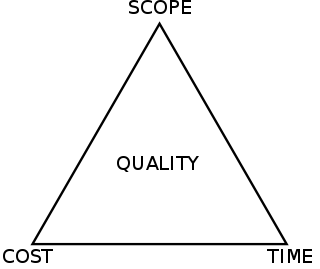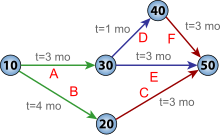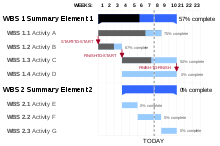Project management is the process of supervising the work of a team to achieve all project goals within the given constraints. This information is usually described in project documentation, created at the beginning of the development process. The primary constraints are scope, time and budget. The secondary challenge is to optimize the allocation of necessary inputs and apply them to meet predefined objectives.

A work-breakdown structure (WBS) in project management and systems engineering is a deliverable-oriented breakdown of a project into smaller components. A work breakdown structure is a key project management element that organizes the team's work into manageable sections. The Project Management Body of Knowledge defines the work-breakdown structure as a "hierarchical decomposition of the total scope of work to be carried out by the project team to accomplish the project objectives and create the required deliverables."
Project management software are computer programs that help plan, organize, and manage resources.
The rational unified process (RUP) is an iterative software development process framework created by the Rational Software Corporation, a division of IBM since 2003. RUP is not a single concrete prescriptive process, but rather an adaptable process framework, intended to be tailored by the development organizations and software project teams that will select the elements of the process that are appropriate for their needs. RUP is a specific implementation of the Unified Process.

A project manager is a professional in the field of project management. Project managers have the responsibility of the planning, procurement and execution of a project, in any undertaking that has a defined scope, defined start and a defined finish; regardless of industry. Project managers are first point of contact for any issues or discrepancies arising from within the heads of various departments in an organization before the problem escalates to higher authorities, as project representative.
In project management, a schedule is a listing of a project's milestones, activities, and deliverables. Usually dependencies and resources are defined for each task, then start and finish dates are estimated from the resource allocation, budget, task duration, and scheduled events. A schedule is commonly used in the project planning and project portfolio management parts of project management. Elements on a schedule may be closely related to the work breakdown structure (WBS) terminal elements, the Statement of work, or a Contract Data Requirements List.

In systems engineering and software engineering, requirements analysis focuses on the tasks that determine the needs or conditions to meet the new or altered product or project, taking account of the possibly conflicting requirements of the various stakeholders, analyzing, documenting, validating, and managing software or system requirements.

In systems engineering, information systems and software engineering, the systems development life cycle (SDLC), also referred to as the application development life cycle, is a process for planning, creating, testing, and deploying an information system. The SDLC concept applies to a range of hardware and software configurations, as a system can be composed of hardware only, software only, or a combination of both. There are usually six stages in this cycle: requirement analysis, design, development and testing, implementation, documentation, and evaluation.

In industry, product lifecycle management (PLM) is the process of managing the entire lifecycle of a product from its inception through the engineering, design and manufacture, as well as the service and disposal of manufactured products. PLM integrates people, data, processes, and business systems and provides a product information backbone for companies and their extended enterprises.
ISO/IEC/IEEE 12207Systems and software engineering – Software life cycle processes is an international standard for software lifecycle processes. First introduced in 1995, it aims to be a primary standard that defines all the processes required for developing and maintaining software systems, including the outcomes and/or activities of each process.
In agile principles, timeboxing allocates a maximum unit of time to an activity, called a timebox, within which a planned activity takes place. It is used by agile principles-based project management approaches and for personal time management.
Construction management (CM) aims to control the quality of a project's scope, time, and cost to maximize the project owner's satisfaction. It uses project management techniques and software to oversee the planning, design, construction and closeout of a construction project safely, on time, on budget and within specifications.
Requirements management is the process of documenting, analyzing, tracing, prioritizing and agreeing on requirements and then controlling change and communicating to relevant stakeholders. It is a continuous process throughout a project. A requirement is a capability to which a project outcome should conform.
Business analysis is a professional discipline focused on identifying business needs and determining solutions to business problems. Solutions may include a software-systems development component, process improvements, or organizational changes, and may involve extensive analysis, strategic planning and policy development. A person dedicated to carrying out these tasks within an organization is called a business analyst or BA.
Software project management is the process of planning and leading software projects. It is a sub-discipline of project management in which software projects are planned, implemented, monitored and controlled.
Internet-Speed development is an Agile Software Development development method using a combined spiral model/waterfall model with daily builds aimed at developing a product with high speed.
The following outline is provided as an overview of and topical guide to business management:

The project management triangle is a model of the constraints of project management. While its origins are unclear, it has been used since at least the 1950s. It contends that:
- The quality of work is constrained by the project's budget, deadlines and scope (features).
- The project manager can trade between constraints.
- Changes in one constraint necessitate changes in others to compensate or quality will suffer.
In software engineering, a software development process or software development life cycle (SDLC) is a process of planning and managing software development. It typically involves dividing software development work into smaller, parallel, or sequential steps or sub-processes to improve design and/or product management. The methodology may include the pre-definition of specific deliverables and artifacts that are created and completed by a project team to develop or maintain an application.
The following outline is provided as an overview of and topical guide to project management:












